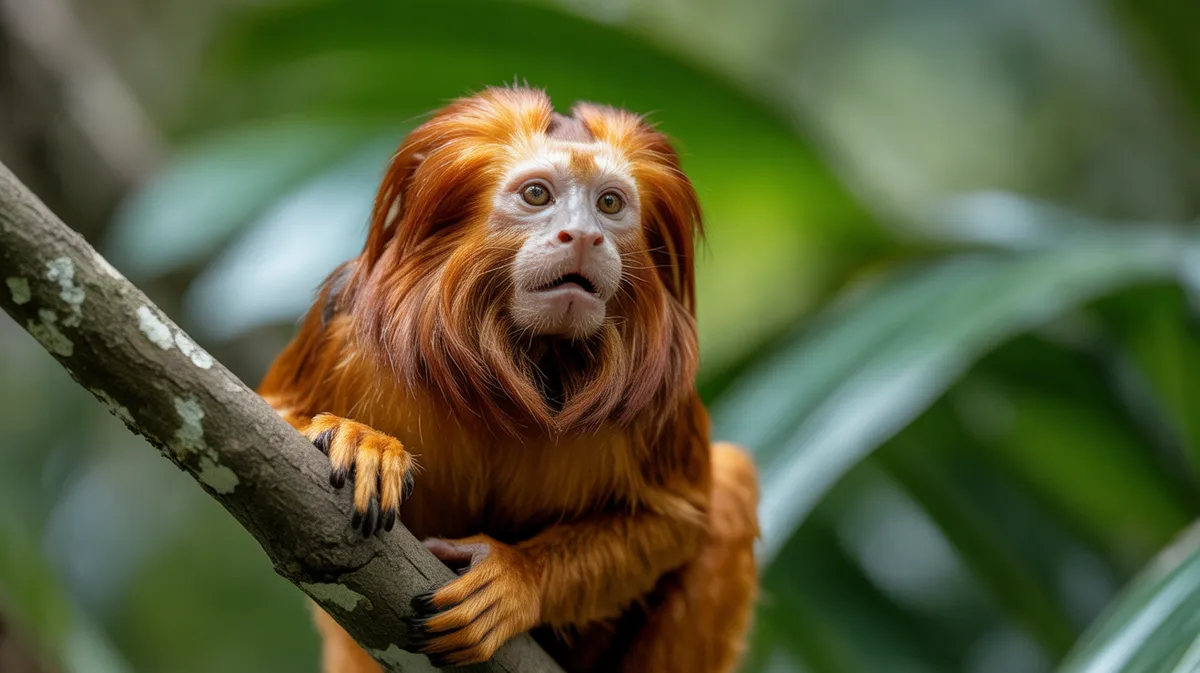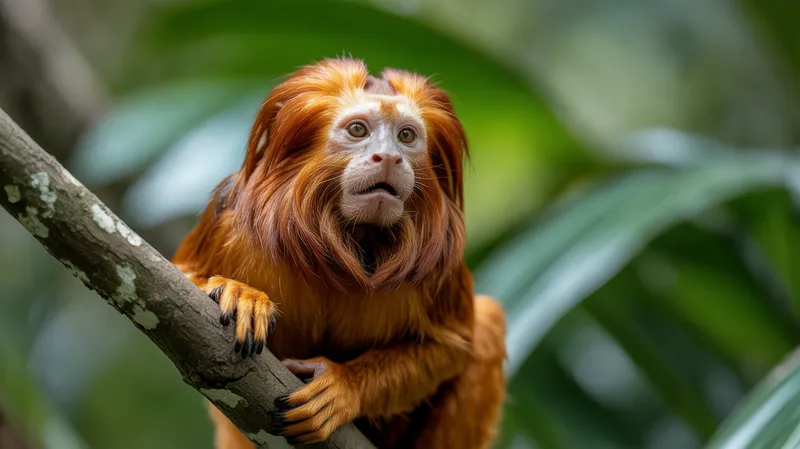
Golden Lion Tamarin
Leontopithecus rosalia

Meet the Golden Lion Tamarin
The Golden Lion Tamarin is a small, vividly colored primate native to the Atlantic coastal forests of Brazil. Its striking golden-orange mane and fur resemble the regal appearance of a lion, despite its diminutive size. Golden Lion Tamarins live in social family groups and display strong bonds, often engaging in grooming and cooperative care of young. Due to habitat loss and fragmentation, their populations have dramatically declined, making them one of the most well-known symbols of conservation efforts in South America.
Classification
Mammal
Habitat
Lowland tropical rainforest
Diet
Omnivore
Lifespan
10-15 years in the wild
Conservation
Endangered
Weight
500-700 grams
📖Fascinating Facts
Majestic Mane
The thick golden mane surrounding the tamarin's face is unique among New World monkeys and helps give it its name.
Arboreal Lifestyle
Golden Lion Tamarins spend almost all their time in the trees, rarely descending to the ground, and use their agile limbs to leap between branches.
Family Matters
They live in tight-knit family groups where both parents and older siblings help care for the young, showcasing cooperative breeding.
📋Detailed Description
The golden lion tamarin (Leontopithecus rosalia) is a small, arboreal primate distinguished by its vibrant golden-orange pelage and an impressive mane encircling its face, reminiscent of a lion’s. Adults typically weigh between 540 and 700 grams and measure 26–33 cm in body length, with a tail that can reach up to 40 cm, aiding in balance but not prehensile. Their hands and feet are equipped with claw-like nails (tegulae) rather than flat nails, an adaptation for clinging to tree trunks and foraging in crevices. Golden lion tamarins are diurnal and highly social, living in cohesive family groups of 2–8 individuals, usually consisting of a breeding pair and their offspring. They exhibit strong territoriality, using scent marking and vocalizations to communicate and defend their home ranges, which average 40 hectares. Their diet is omnivorous, including fruits, flowers, nectar, insects, small vertebrates, and bird eggs, with a preference for high-energy foods. Social grooming is a central activity, reinforcing bonds and group cohesion. Reproduction is typically seasonal, with most births occurring during the rainy season when food is abundant. Both parents, as well as older siblings, participate in infant care, a behavior known as cooperative breeding. The species is critically dependent on the complex structure of the Atlantic Forest, utilizing dense canopy and vine tangles for shelter and foraging.
💡 Did you know?
All Golden Lion Tamarins living in the wild today descend from just a few dozen individuals, making genetic diversity a major conservation concern.
🔬Research & Sources
Wikipedia Summary
The golden lion tamarin, less commonly known as the golden lion marmoset, is a small New World monkey of the family Callitrichidae. Endemic to the Atlantic coastal forests of Brazil, the golden lion tamarin is an endangered species. The geographic range is entirely within the state of Rio de Janeiro. A 2022/2023 census estimated about 4,800 individuals living in the current primary area of occurrence in the non-coastal area of the São João and Macaé river basins, with unknown but smaller additional numbers in limited coastal forests and to the west of the primary area of occurrence. There is a captive population maintaining about 490 individuals among 150 zoos.
Last Modified: 6/10/2025
🎭Behavior & Social Structure
Golden lion tamarins are active from dawn to dusk, spending the night in tree hollows or dense vine tangles for protection against predators. They travel through the mid to upper canopy in coordinated family groups, using a combination of quadrupedal running, leaping, and climbing. Foraging is a group activity, with individuals probing bark, bromeliads, and leaf litter for insects, spiders, and small vertebrates, while also consuming fruits and nectar. They communicate through a rich repertoire of vocalizations, including whistles, trills, and alarm calls, as well as olfactory and tactile signals. Social hierarchy is maintained through grooming, play, and occasional aggression, but group cohesion is generally strong. Territorial disputes with neighboring groups are resolved through vocal displays and scent marking rather than physical confrontation. Rest periods are interspersed with bouts of feeding and social interaction throughout the day.
👶Reproduction & Life Cycle
Golden lion tamarins are generally monogamous, with a dominant breeding pair in each group. The breeding season aligns with the rainy season (September to March), optimizing food availability for lactating females and growing infants. Females typically give birth to twins after a gestation period of about 130–135 days. Cooperative care is a hallmark of the species: fathers and older siblings carry the infants, returning them to the mother for nursing. Infants are weaned at 3 months and reach independence at 4–5 months. Sexual maturity is reached at 18–24 months. Reproductive success is closely linked to group stability and resource availability, with high infant mortality in fragmented or degraded habitats.
🛡️Adaptations & Survival
Golden lion tamarins possess several adaptations for arboreal life, including elongated fingers and claw-like nails for extracting insects and gripping branches. Their small size and agility allow them to navigate dense forest canopies and exploit food resources inaccessible to larger primates. The bright coloration may serve as camouflage among the sun-dappled foliage or as a social signal within groups. Their complex vocalizations facilitate communication in visually obstructed environments. Cooperative breeding increases offspring survival in a habitat where predation risk is high and food resources are patchy. Their diet flexibility enables them to exploit a wide range of food sources, an advantage in the highly seasonal Atlantic Forest.
📚Research Sources
🎨Cultural Significance
The golden lion tamarin is an iconic symbol of Brazil’s Atlantic Forest and a flagship species for global conservation efforts. It features prominently in environmental education campaigns and ecotourism initiatives, raising awareness about biodiversity loss. The species has become a national emblem, appearing in Brazilian postage stamps, coins, and conservation logos. While there is no significant role in indigenous mythology or traditional medicine, its striking appearance and endangered status have made it a subject of international attention and pride.
🔬Recent Research & Discoveries
Recent research has focused on the genetic health of wild and reintroduced populations, the effectiveness of habitat corridors in promoting gene flow, and the impact of emerging diseases such as yellow fever. Studies using GPS telemetry have provided insights into home range use, dispersal patterns, and the importance of specific tree species for nesting and foraging. Behavioral ecology research has documented the benefits of cooperative breeding and the role of kinship in group stability. Ongoing projects include habitat restoration, reforestation with native species, and community-based conservation programs involving local landowners. The species is also a model for studying the effects of habitat fragmentation on primate social systems and genetic diversity.
🎥Wildlife Videos

The Two Times We Saved Golden Lion Tamarins from Extinction | WILD HOPE
The golden lion tamarin stands as a beacon of hope and survival in the face of extinction after an outbreak of yellow fever led to a ...
Nature on PBS

Golden Lion Tamarin | The golden lion tamarin is a small monkey native to the coastal Brazil.
Sometimes called a golden marmoset, it has a long tail, reddish-gold fur, and a dramatic mane that frames its face. Due in part to a ...
Animal Square

5 Amazing Facts About Golden Lion Tamarins in Brazilian Rainforest
Explore the enchanting world of the Golden Lion Tamarin in our latest documentary, "Rare Monkeys Living in Brazilian Rainforest.
Ases World

Golden Lion Tamarin The Hidden Gem of the Amazon
In this captivating video, we delve into the world of the Golden Lion Tamarin, a rare and mesmerizing wildlife species found in the ...
PVergz TV

Golden Lion Tamarin, endemic animal from Brazil
Golden Lion Tamarin, endemic animal from Brazil #animalchannel #animaleducation #animals #worldanimaltv #animal ...
World Animal TV

Amazing Curiosities - Golden Lion Tamarin
Did you know that the golden lion tamarin is one of the most fascinating and endangered animals in Brazil? In this video, we delve ...
Brazil Curiosities
🌍Habitat Information
The Golden Lion Tamarin typically inhabits Lowland tropical rainforest environments. Golden Lion Tamarins have adapted to their environments with specialized features and behaviors.
Primary Habitat:
Lowland tropical rainforest
More detailed habitat information will be available soon.
🛡️Conservation Status
The Golden Lion Tamarin is currently classified as Endangered. Conservation efforts are crucial for preserving this species for future generations.
Common Threats:
- 🏠Habitat loss and fragmentation
- 🌡️Climate change impacts
- 🎯Hunting and poaching
- 🏭Human-wildlife conflict
⚠️Threats & Conservation Challenges
The primary threats to golden lion tamarins are habitat loss and fragmentation due to deforestation for agriculture, pasture, and urban development in Brazil’s Atlantic Forest, which has been reduced to less than 12% of its original extent. Small, isolated populations are vulnerable to inbreeding depression, disease, and stochastic events. Illegal pet trade and occasional hunting also pose risks. Conservation challenges include maintaining and restoring habitat connectivity, managing genetic diversity, and mitigating human-wildlife conflict. Despite intensive conservation efforts, including translocations, reintroductions, and the creation of biological corridors, the species remains endangered, with wild populations estimated at around 4,800 individuals as of 2023. Captive breeding programs in zoos worldwide play a crucial role in genetic management and public awareness.
🔬Scientific Classification
Scientific Name
Leontopithecus rosalia
Classification Hierarchy
🔍 About Taxonomic Classification
Taxonomic classification is a hierarchical system used by scientists to classify and organize living organisms based on shared characteristics and evolutionary relationships.
The system moves from broad categories (Kingdom) to increasingly specific ones, with each animal's scientific name typically consisting of its Genus and species.
📝Community Notes
Share your observations and insights about the Golden Lion Tamarin with our community of wildlife enthusiasts.
Join Our Community
Sign in to share your observations and connect with fellow wildlife enthusiasts.
Sign In to ContributeNo community notes yet
Be the first to share your observations about the Golden Lion Tamarin!
Explore Golden Lion Tamarin
Select a tab above to learn more about this amazing animal.
📸Photo Gallery
No photos available for this animal yet.
🌟Discover More Wildlife
Continue your journey of discovery with more fascinating animals from our database
